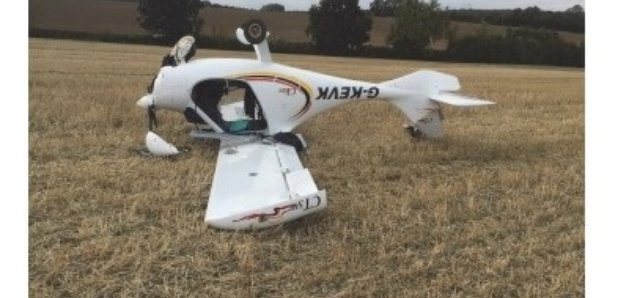Northants Aircraft Crash - Report Says Accidental
10 January 2019, 11:47 | Updated: 10 January 2019, 12:04

An air accident investigation's found the cause of a light aircraft crash in Northamptonshire last year was accidental.
The two-seater came down in a field last September (15th) on it's way back to Sywell after the engine stopped - the aircraft ended upside down in a field.
Both pilots managed to survive
THE REPORT
The Air Accident Investigation Branch (AAIB) have concluded their investigation into last Autumn's light aircraft crash in a field in Northamptonshire.
The AAIB say:
"After completing a local flight, the occupants of G-KEVK were positioning the aircraft for a return to Sywell Airfield. Approximately 5 nm from Sywell, the engine ‘coughed’ and then stopped.
The pilot flying positioned the aircraft for a forced landing in a stubble field. After landing the nosewheel struck a tractor furrow and the nose landing gear collapsed.
The aircraft came to rest upside down in the field. Neither occupant was injured.
The cause of the engine failure could not be positively determined although it was suspected that it was caused by issues with the fuel supply. It was possible that there was water in the fuel which the pilots were unable to check, or that air was drawn into the fuel system due to a low fuel level and the design of the system.
History of the flight
G-KEVK was prepared for a local flight from Sywell Airfield, Northamptonshire. Before departure the fuel tanks were checked to ensure that the fuel was more than sufficient for the planned short flight plus contingencies. After departing from Sywell, the two occupants,
both qualified pilots on the aircraft type, decided to proceed to Denethorpe Airfield to carry out some circuit practise. Having completed four circuits at Denethorpe, the aircraft departed to the west to do some local sightseeing. Having flown over Market Harborough, the occupants decided that it was time to return to Sywell and began a left turn to position the aircraft for its approach to the airfield.
As they approached approximately 5 nm from the airfield, the pilots heard the engine ‘cough’ and then stop. The pilot who was flying the aircraft at the time began to scan for a suitable field. He observed that most of the fields appeared newly ploughed but that there was a long field that looked to have a stubble surface although it was not into wind. The pilot considered that there was little or no other choice than to accept a downwind landing into this field as he did not have the height to position the aircraft for an into-wind landing.
As a result, the touchdown was at a higher groundspeed than the pilot would have liked. The aircraft type is not fitted with suspension and has disc brakes on its main wheels. The pilot was beginning to apply the brakes gently to avoid locking the wheels when the nose dropped suddenly and the aircraft lurched forward, coming to rest upside down as show in
The aircraft landed in a field of stubble which contained numerous tractor furrows. The CTSW undercarriage is not constructed for rough terrain and photographs of the accident site suggested that the nosewheel struck a tractor furrow before the aircraft speed had been reduced significantly.
This caused the collapse of the nose landing gear and pitched the aircraft onto its roof. Both occupants were able to vacate the aircraft unaided and neither suffered any injuries. "





















